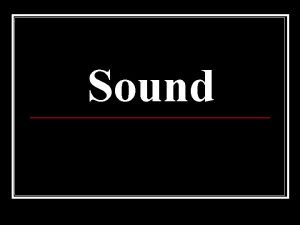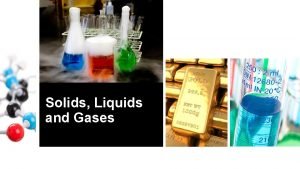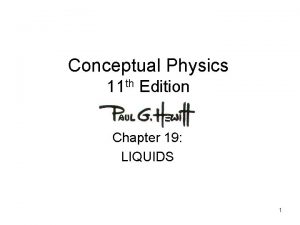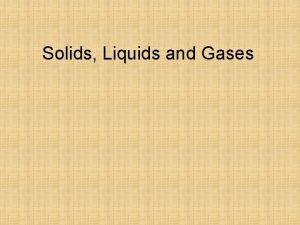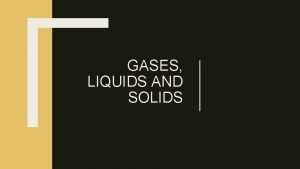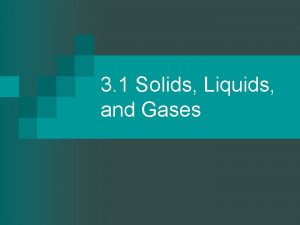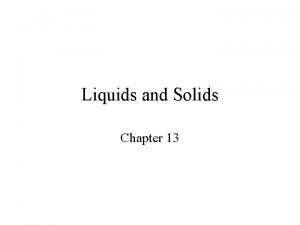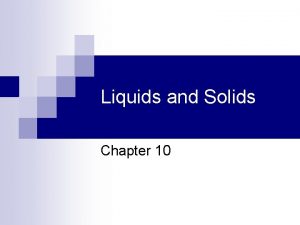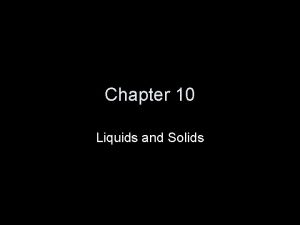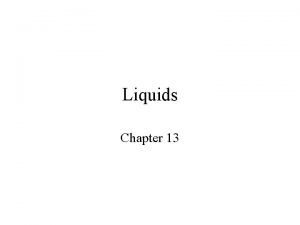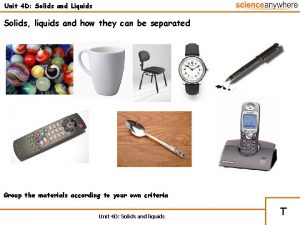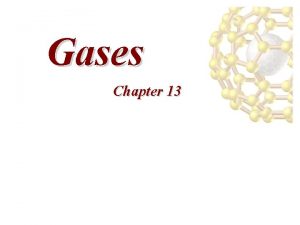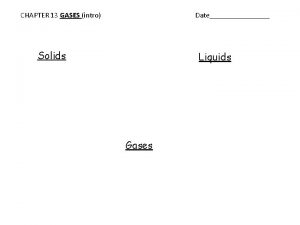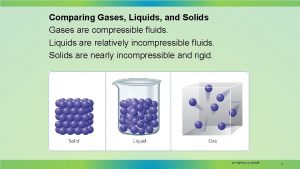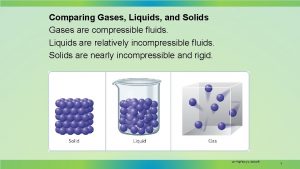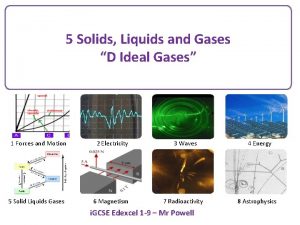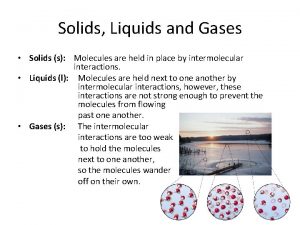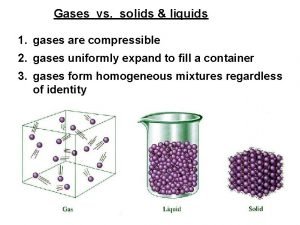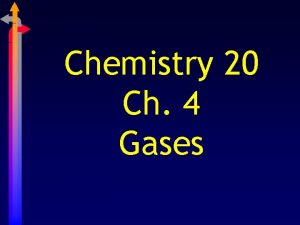Chapter 3 Solids Liquids and Gases Solids A




















- Slides: 20

Chapter 3 Solids, Liquids and Gases

Solids • A solid has a definite shape and a definite volume. • The particles in a solid are closely locked in position and can only vibrate. • 2 types of solids exist – Crystalline solids: are solids that are made up of crystals. Examples are salt, sugar, and snow. – Amorphous solids: these contain particles that are not arranged in a regular pattern. Amorphous solids do not melt, instead they become softer. Examples are plastics, rubber, and glass.

Liquids • A liquid has a definite volume but no definite shape of its own. • Compared to particles in a solid, the particles in a liquid are more loosely connected and can collide with and move past one another. • A liquid is an example of a fluid, meaning a “substance that flows. ”

Liquids Continued • One characteristic property of liquids is surface tension. • Surface tension is the result of an inward pull among the molecules of a liquid that brings the molecules on the surface closer together. • Another property of liquids is viscosity, which is a liquids resistance to flowing. • Liquids with high viscosity flow slowly and liquids with low viscosity flow quickly.

Gases • A gas can change volume very easily – it has no shape or volume. • In gases, the atoms and molecules are free to move independently, colliding frequently. The distance between particles in a gas is much larger than the distance between particles in a solid or a liquid.


Changes of State • The change in state from a solid to a liquid is called melting. In most pure substances, melting occurs at a characteristic temperature called the melting point. • When a substance melts, the particles in the solid vibrate so fast that they break free from their fixed positions. • Freezing is when a change from a liquid to a solid occurs. When a substance freezes, the particles in the liquid move so slowly that they begin to take on fixed positions.

Changes between Liquid and Gas • The change from a liquid to a gas is called vaporization. It takes place when the particles in a liquid gain enough energy to move independently forming a gas. • Vaporization that takes place only on the surface of a liquid is called evaporation. • Boiling occurs when a liquid changes to a gas below its surface as well as at the surface. The boiling point of a substance depends on the pressure of the air above it. The lower the pressure, the less energy needed for the particles of the liquid to escape into air.


Changes continued • Condensation is the change in state from a gas to a liquid. • During condensation, the particles in a gas lose enough thermal energy to form a liquid.

Changes between Solid and Gas • Sublimation occurs when the surface particles of a solid gain enough energy that they form a gas. • During sublimation, particles of a solid do not pass through the liquid state as they form a gas.


Measuring Gases • When working with a gas, it is helpful to know its volume, temperature, and pressure. • Volume is the amount of space that matter fills, measures in cm 3, m. L, L and other units. • Temperature is a measure of the average energy of motion of the particles of matter. • The pressure of the gas is the force of its outward push divided by the area of the walls of the container, measured in units of pascals.

Temperature and Volume • Charles’s Law – When the temperature of a gas is increased at constant pressure, its volume increases. When the temperature of a gas is decreased at constant pressure, its volume decreases. – The graph of Charles’s Law shows that the volume of a gas is directly proportional to its Kelvin temperature under constant pressure. – When a graph of 2 variables is a straight line passing through the origin, the variables are said to be directly proportional to each other.


Pressure and Volume • Boyle’s Law – When the pressure of a gas at constant temperature is increased, the volume of the gas decreases. When the pressure is decreased the volume increases. – The graph of Boyle’s law shows that gas pressure is inversely proportional to the volume at constant temperature.



Pressure and Temperature • Ideal Gas Law – When the temperature of a gas at constant volume is increased, the pressure of the gas increases. When the temperature is decreased, the pressure of the gas decreases. – Pressure and temperature are directly related.

 Chapter 14 solids liquids and gases worksheet answers
Chapter 14 solids liquids and gases worksheet answers Kinetic molecular theory of solid
Kinetic molecular theory of solid Expansion of solids liquids and gases examples
Expansion of solids liquids and gases examples Solids liquids and gases section 2 properties of fluids
Solids liquids and gases section 2 properties of fluids Conduction convection radiation venn diagram
Conduction convection radiation venn diagram What are the properties of solids
What are the properties of solids Combined gas law def
Combined gas law def Lesson outline lesson 1 solids liquids and gases answer key
Lesson outline lesson 1 solids liquids and gases answer key Particle movement in solids liquids and gases
Particle movement in solids liquids and gases How does sound travel through solids liquids and gases
How does sound travel through solids liquids and gases Matter and its composition
Matter and its composition Motion of particles in solids, liquids and gases
Motion of particles in solids, liquids and gases Why are gases easy to compress?
Why are gases easy to compress? Chapter 11 - states of matter: liquids and solids
Chapter 11 - states of matter: liquids and solids Molecular theory of gases and liquids
Molecular theory of gases and liquids Site:slidetodoc.com
Site:slidetodoc.com Kinetic molecular theory of liquids and solids
Kinetic molecular theory of liquids and solids Liquids and solids menu
Liquids and solids menu Kesler science.com
Kesler science.com Filter medium resistance formula
Filter medium resistance formula Chapter 19 liquids exercises answers
Chapter 19 liquids exercises answers









